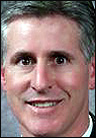RFID technology is rising out of a trough of disillusionment for many RFID technology providers, according to David Hogan, senior vice president and CIO of the National Retail Foundation, a trade association for U.S. department stores, supermarkets, drug stores, chain restaurants, discount stores and other retailers.
In 2002, RFID was widely expected to revolutionize the way retailers managed inventory, Hogan says. In the ensuing years, however, the expense of RFID labels and readers, in conjunction with the effectiveness of existing bar-coding systems, cooled enthusiasm for RFID for many retailers and their suppliers. That may be changing, he says, as large retailers continue with pilot programs and as the cost of individual RFID chips and labels continues to drop.
“Initially, expectations were so high, it was not realistic,” Hogan explains. The extent of hype by RFID equipment manufacturers and vendors made the slow adoption a disappointment for RFID watchers. “The future of RFID is a slow and measured adoption,” he says, adding that it took retailers 10 to 12 years to adopt bar-coding systems, and that it may take longer for RFID since it is a more complex technology.
Currently, the cost to apply bar codes on packaging is a fraction of a cent, as opposed to an average of 20 to 25 cents for RFID labels, according to those retailers with whom Hogan has spoken. He predicts the price of RFID tags will drop to about 12 to 15 cents apiece by the end of the year, helping RFID tagging to advance beyond case and pallet to the item level.
Despite the high cost of tags, Hogan maintains, many retailers and their suppliers could benefit by tagging higher-priced items in their stores today. Three international retailers have led the way in that category. One is the $64 billion U.K. retailer Tesco, which has tested smart shelves for DVDs and CDs, allowing store associates to use RFID readers to determine when an item is misplaced on the shelf (see Europe Finds Its Own Path to ROI). Another example is Marks and Spencer (M&S), which is tagging some men’s suits, enabling its salespeople to run inventory checks with handheld readers (see RFID Is In Fashion). Moreover, German retailer Metro is using RFID chips in its “customer-loyalty” cards at the Metro Future Store in Rheinberg (see RFID for Your Shopping Cart).
“I think, at some point in time, we will see the price of tags go down to a nickel or less,” says Hogan, who does not expect consumer privacy concerns to impact RFID’s growth in retail. By fully disclosing to customers how the technology is being used and showing them its benefits, he asserts, retailers can obviate any privacy concerns.
Other technology on the horizon for retailers, Hogan reports, includes RFID-enabled self-checkouts, contactless payment systems using credit and debit cards with embedded RFID tags, and payments systems based on finger scans or other biometrics.


